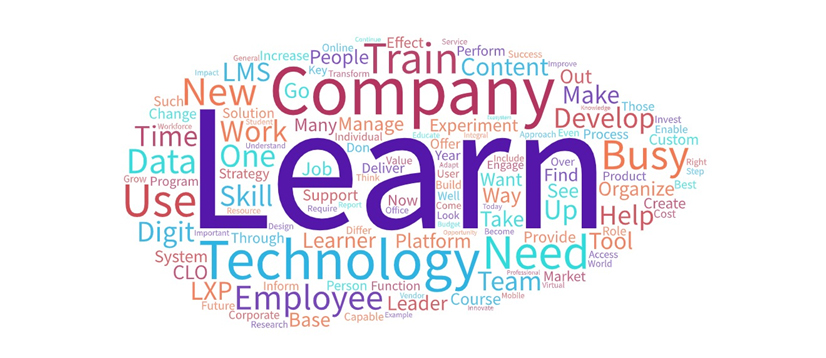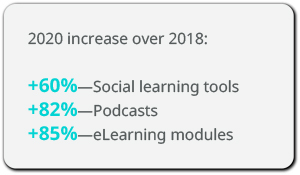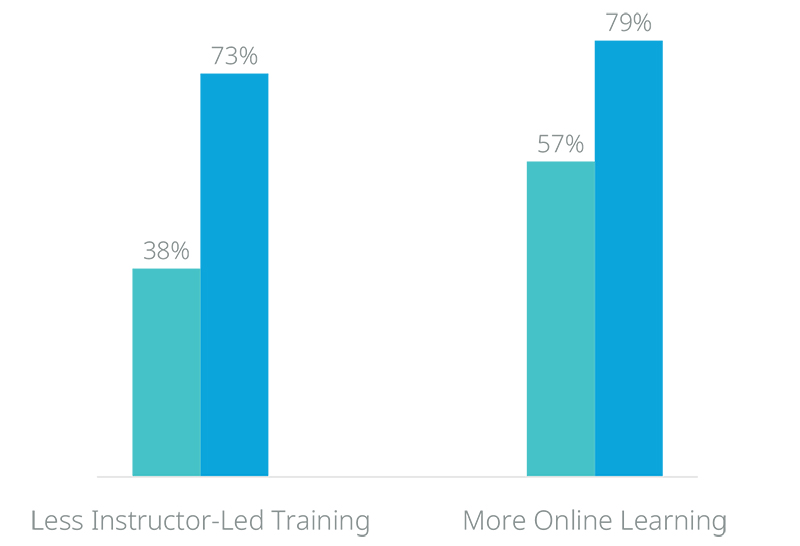Building Learning Tech Ecosystems: What the Literature Says 2 Years Later
March 15th, 2021
About 2 years ago, as part of our research on learning tech ecosystems we conducted an in-depth lit review on how to create such an ecosystem. We were looking for thoughtful, credible insights on how orgs, vendors, and thought leaders were approaching the question of how to build truly effective learning tech ecosystems that meet org and employee needs. Given how many vendors we'd seen offering point solutions rather than all-encompassing platforms, we were surprised at the dearth of credible sources on the topic.
In more recent research, we noted that learning tech is booming—with more vendors, more customers, more users, more functionalities, and more choice than ever before.1 Some of this growth is due to COVID-19: Learning tech got a shot in the arm during the pandemic as orgs scrambled to pivot their businesses—and the learning strategies that support them—to keep up with the massive changes occurring in their environments.
And, while some growth in learning tech was already happening (or forecasted) even before the pandemic, the upheavals of the past year have made this question much more urgent—and critical:
How should orgs be thinking about creating their learning tech ecosystems?
In other words, with so many learning tech options and so many ways to fit the pieces together, how can orgs choose tech to build the ecosystem that’s right for them?
So we decided to look at the literature again. We wanted to see if, in the past 2 years, articles on learning tech ecosystems have started pushing the thinking beyond the pedestrian. As it turns out, in some areas the thinking has moved forward—for example around learning budgets—but the advice in the literature is still largely fragmented and tactical.
Themes from the Literature
We reviewed the current literature on the topic of choosing learning tech to identify any models, frameworks, or thought leadership on creating learning tech ecosystems. The text of the 40 articles we reviewed resulted in the following word cloud (see Figure 1).

Figure 1: Lit Review Word Cloud | Source: RedThread Research, 2021.
The word cloud highlights one of our early observations during this research:
The meaning behind “choosing learning tech” is changing.
Notice in Figure 1 that LMS and LXP are the only types of learning tech mentioned enough times in the literature to show up in the word cloud. This reflects the historic meaning of “choosing learning tech.” This phrase used to mean choosing the best LMS—or, if you were really forward-leaning, LXP—for your org. But there’s so much more to the universe of learning tech—a fact that shows up in some of the other words in Figure 1 like data, digital, experiment, change, and perform. That wasn't the case when we did the last lit review 2 years ago.
This shift towards an awareness of the wider learning tech universe is reflected in the 5 themes we identified from the literature:
- Learning budgets are shifting toward tech
- Don’t let the tail wag the dog: learning tech decisions should be made in service of business and learning strategies
- Advice in the literature is fragmented and tactical
- Choosing learning tech doesn’t (necessarily) mean buying learning tech
- L&D teams need technologists
Let’s dive into these 5 themes in more detail.
Learning budgets are shifting toward tech
By Q1’2020, most L&D budgets for the year had been set. As the COVID-19 pandemic arrived on the scene, a few orgs decided to increase their overall learning budgets to invest more than originally planned in employee development. Many more orgs, however, decided to simply shift existing funds from planned in-person training to expand virtual and online development opportunities—all of which is supported or delivered by learning tech.
Overall, orgs significantly increased their usage of online and collaborative modalities, with considerable increases in 3 types of tech tools in particular:2

The shifting trend toward tech is here to stay: As illustrated in Figure 2, in 2021, almost three-fourths (73%) of learning professionals expect to do less instructor-led training (ILT), and almost four-fifths (79%) anticipate doing more online learning.3

Figure 2: Percentage of L&D Professionals Expecting Investment Changes—ILT vs Online |
Source: LinkedIn Learning, 2021.
Tech decisions must serve strategy
Don’t let the tail wag the dog: Tech decisions should be made in service of business and learning strategies.
A prominent theme in the literature is linking tech decisions to strategy. Many articles we reviewed emphasized the importance of understanding what your org is trying to achieve before deciding what tech is needed. Otherwise learning leaders risk investing in tech they don’t need and probably won’t use.
We particularly appreciated the point by two authors, Nan Guo and Bülent Gögdün, that in some orgs:
“… What goes wrong is the wasteful spending to signal innovativeness without solving a real problem.”4
Bottom line: While it may be tempting to experiment with new technologies, it's important to remember that novelty doesn't necessarily solve business problems. Instead, learning leaders must clearly identify what they want to achieve through employee development—what business results they seek to support—and look for the tech solution(s) that can help realize those goals.
Advice in the literature—Fragmented & tactical
The literature contains many, many articles on how to choose specific types of learning tech—an LXP, an LMS, or the latest VR tech, for example.5 As we saw in the word cloud above, LMSs and LXPs are far more represented than any other type of learning tech.
Where the literature falls short: Most articles don’t account for the incredible range of available tech that can be leveraged for learning—or how to fit the various pieces together into a cohesive ecosystem6 which evolves over time. Although some helpful checklists (provided by vendors) exist to help buyers think through various aspects of a learning tech purchase, most of these checklists focus on each vendor’s area of expertise.7
We see an opportunity to write about more holistic approaches to choosing learning tech.
These specific, tactical articles are very helpful—if you already know what tech you need. But there's not much in the literature for those leaders who need to step back, identify needs, and take a more holistic approaches to choosing learning tech.
Choosing learning tech doesn’t (necessarily) mean buying learning tech
Some articles in our lit review noted the importance of understanding the full capabilities of the tech already in-house. According to one source, 89% of orgs already use at least 3 learning tech platforms.8
89% of orgs already use at least 3 learning tech platforms—and most platforms aren’t being fully leveraged.
There’s a good chance that in-house platforms offer features and functionalities that could support learning needs—and which aren’t currently being used. This situation often arises because a platform is purchased to meet one need (or set of needs) and only certain functionalities are turned on to meet those needs, even though the platform has more to offer. In other cases, vendors add functionalities during platform updates.
Some orgs also have the in-house capability to build systems, processes, and / or platforms to meet learning objectives.
So, before making any additional purchases, it’s critical to understand what features already exist—or could be built in-house—and how they might be leveraged. Considering all the different ways to acquire tech—not just buying—can help learning leaders make the most effective, cost-efficient learning tech decisions.
L&D teams need dedicated learning technologists
The fact that most orgs already have multiple learning tech solutions makes any learning tech decision more complex. L&D leaders must not only ask what already exists—as discussed in the previous section—but also how any new tech would integrate with existing systems.
Enter the learning technologist!
Learning technologists have unique skills—amounting increasingly to full-time jobs and, in some orgs, entire teams—that allow them to:
- Truly understand the learning tech that’s available in the market
- Envision how learning tech might help solve an org’s specific business challenges
- Figure out how all the different pieces of tech can be leveraged and assembled / integrated together
Traci Cantu, then-director of learning technology at Whole Foods, emphasized in a podcast that learning tech bridges the worlds of HR, IT, operations, and learning.9 It’s helpful to have team members dedicated to understanding and navigating this nexus.
Or, as another article put it, in the L&D orgs of the future:
“Learning technologists will design and implement the right technology stack with the right mix of tools—from traditional learning management systems (LMSs) to modern learning experience platforms (LXPs)—and fit-for-purpose learning apps.”10
Next, we take a closer look at some of the key articles we discovered in our lit review.
Sources That Caught Our Attention
Several articles—and one podcast—in the literature illuminated key considerations about choosing learning tech. The sources below contain insights we found both intriguing and helpful. We learned from their perspectives and encourage you to do the same.
Three Steps to Turn Your Company into a Learning Powerhouse
Andrew Dyer, Susanne Dyrchs, J. Puckett, Hans-Paul Buerkner, Allison Bailey, and Zhdan Shakirov | BCG, November 2020
This article outlines how to put learning at the forefront of the org. It includes tech as 1 factor to consider, situating tech decisions within the overall learning and business strategies.
“Does your company have the necessary infrastructure—the tools and technology—to measure, support, and continuously improve the learning ecosystem?”
Highlights:
- The 5 domains that make learning ecosystems successful are:
- A refined strategy
- A mature learning org
- High-quality offerings (library of content)
- Enablers / infrastructure to support delivery
- “Learnscape integration”—a community of providers inside and outside the org
- The authors developed a set of questions to evaluate these 5 domains, including learning tech in the “enablers” domain
- CEOs must measure learning capabilities against KPIs
- Orgs must assuage leaders’ fear of investing in employee development only to lose those people to other teams or even other orgs entirely
Workplace Learning Report: Skill Building in the New World of Work
LinkedIn Learning, 2021
This comprehensive article on the state of learning in the workplace highlights a number of key trends that resulted from or were accelerated by the COVID-19 pandemic. The section on L&D budgets is particularly relevant for this research on choosing learning tech.
64% of L&D pros globally agree was the moment learning shifted from a “nice to have” to a “need to have.”
Highlights:
- L&D has gained a lasting seat at the C-suite table as CEOs continue to prioritize learning; as a result, L&D budgets are likely to continue increasing
- The pivot from instructor-led training to virtual / online learning is here to stay—as reflected in learning budgets, which are allocating far more to tech than previously: 79% of L&D pros expect to spend more on online training in 2021
- Upskilling, reskilling, and internal mobility are top priorities for orgs and L&D in 2021
- Resilience and digital fluency are the most important skills cited by L&D leaders
Navigating the Corporate Training Market During the COVID-19 Pandemic
Ken Taylor | Training Industry, April 2020
This article offers a great snapshot of the state of learning tech at the beginning of the COVID-19 pandemic. It reflects much of the uncertainty in the market and offers advice to vendors about how to best serve L&D teams struggling to pivot quickly.
TrainingIndustry.com has seen an 8.6% increase in web traffic over the past few weeks , with an 8,135% increase in topics related to remote learning, virtual instructor-led training (vILT), and leading through adversity and change.
Highlights:
- Although some learning tech spending was put on hold in the early days of the pandemic, as of April 2020, orgs appeared ready to increase spending on learning tech
- Prepandemic:
- 89% of companies surveyed already had more than 3 learning tech solutions in place, and almost a quarter (23%) had 9 solutions
- More than 20% of companies planned to increase their investments in learning management systems (LMSs), eLearning, digital content solutions, social / collaboration tools, and delivery platforms
- Two-thirds of companies felt they were ready to introduce new training tech
- While the pandemic enabled greater spending on tech, “old problems still exist”; orgs still need to cultivate a strong L&D strategy
A review of L&D budget allocations in 2020
Rocco Brudno | Coassemble & Brandon Hall Group, November 2020
This article describes the changes in L&D budgets in 2020, including helpful statistics on overall budget shifts as well as data on how learning tech priorities change based on on org size.
The majority of businesses didn’t shrink their L&D budgets in 2020 but rather shifted, and in some cases, expanded them.
Highlights:
- The majority of L&D budgets did not decrease and, in fact, some increased in 2020
- 83% of small businesses and 97% of large businesses that responded to this article’s survey reported the use of an LMS, and almost one-half of businesses said they keep their LMS for more than 4 years
- Almost one-half of businesses surveyed didn't know how much their LMS costs per learner annually
- In addition to LMSs, video platforms and authoring tools were the most valued learning tech solutions among survey respondents, while microlearning and coaching / mentoring solutions were also seen as valuable
Navigating the Purchasing Minefield
Christopher Lind and Jordan Fladell | Learning Tech Talks, February 2020
This frank and fun podcast illuminates many of the landmines in the learning tech purchasing process, and provides helpful, practical insights to learning leaders about how to avoid or mitigate those challenges.
You need to know in detail what L&D must support, what your learning tech systems already can do, and what they can't. And where they can't—that's where you say, “We need X new tech.” Then you have your case built and your internal stakeholders onboard.
Highlights:
- The RFP process is currently broken—it’s a check-the-box exercise that just encourages L&D leaders to chase features
- L&D leaders need to clearly understand the business challenges most important to their org—and select learning tech that can help solve those issues
- Learning leaders must set a scope for their due diligence searches to avoid being overwhelmed by the choices out there
- Selecting the right learning tech includes understanding whether a new tech can integrate with existing systems exactly as your org needs them to
Additional Reading Recommendations
- Why It’s Time to Bring Learning to the C-Suite, BCG / Dyer, A., Dyrchs, S., Bailey, A., Buerkner, H., and Puckett, J., 2020.
- Designing a learning technology ecosystem, Elucidat / Greany, S., 2020.
- Demand More from Your Corporate Learning Budget in 2021, Forbes.com / Guo, N., and Gogdun, B., 2021.
- Making the Best Technology Purchasing Decisions , Shaelynn Farnsworth, 2018.
- SHRM: Some Industries Boost Training in New Technology, Equipment During Pandemic, SHRM / Gurchiek, K., 2020.
Heather Gilmartin Adams
Footnotes
- The Learning Tech Landscape: More, Just More, RedThread Research / Dani Johnson, 2020.
- A review of L&D budget allocations in 2020, Coassemble, 2020.
- Workplace Learning Report: Skill Building in the New World of Work, LinkedIn Learning, 2021.
- Demand More From Your Corporate Learning Budget In 2021, Forbes.com / Guo, N. and Gogdun, B., 2021.
- For example: How to Choose a Learning Management System (LMS) – and Get it Right, Leading Learning, 2019; Learning Experience Platform (LXP): The Definitive Guide, Valamis, 2021; or The Beginner’s Guide to Choosing Corporate eLearning Software, HR Technologist, Biswas, S., 2019.
- The Art and Science of Designing a Learning Tech Ecosystem, RedThread Research / Dani Johnson & Priyanka Mehrotra, 2020.
- Two good, though narrowly defined, checklists include: Learning Technology Selection Quick Guide, WeLearn, 2020; and “Selecting a Learning Management System: Be Strategic!” Learning Solutions Magazine / Brandon, B., 2021.
- Navigating the Corporate Training Market During the Covid-19 Pandemic, Training Industry / Taylor, K., 2020.
- Designing a learning technology ecosystem, Elucidat / Greany, S., 2020.
- Why It’s Time to Bring Learning to the C-Suite, BCG / Dyer, A., Dyrchs, S., Bailey, A., Buerkner, H., and Puckett, J., 2020.